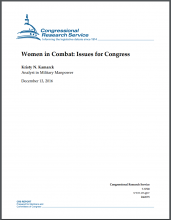By the Numbers - Jan. 9, 2017
1776
The year in which "Margaret Cochran Corbin became the first woman to receive a military pension from Congress for an injury sustained while helping to defend Fort Washington against British troops," according to a recently updated Congressional Research Service (CRS) report -- Women in Combat: Issues for Congress -- made available by the Federation of American Scientists Project on Government Secrecy.
The report notes that in the early part of the 20th century, there was strong opposition "from military commanders, Congress, and the public" to women in the armed services. However, this changed during World War II because of "the upsurge in manpower needs."
Social change in the 1960s and 1970, plus the advent of the all-volunteer military in 1973, led to further increases in women's participation in the armed forces. Laws restricting women from serving in "air and naval combat units" were repealed in the early 1990s. In the next decade, the wars in South Asia and the Middle East changed the situation even further.
Despite the official policies barring women from ground combat positions, many female servicemembers have served in combat environments for much of the recent history of the U.S. military. In the past two decades of conflict in Iraq and Afghanistan, the lines between combat and noncombat roles have become increasingly blurred and as a result DOD’s combat exclusion policies have been called into question.
In January 2013, then-Secretary of Defense Leon Panetta eliminated the restriction on women from serving in combat units, "and directed the military departments to review their occupational standards and assignment policies for implementation no later than January 1, 2016." And in December 2015, Secretary of Defense Ashton Carter "ordered the military to open all combat jobs to women with no exceptions.
This informative CRS report provides background on women's participation in the armed services, discusses recent changes regarding combat roles, and looks at "oversight issues for Congress as DOD implements new policy changes."
1776
The year in which "Margaret Cochran Corbin became the first woman to receive a military pension from Congress for an injury sustained while helping to defend Fort Washington against British troops," according to a recently updated Congressional Research Service (CRS) report -- Women in Combat: Issues for Congress -- made available by the Federation of American Scientists Project on Government Secrecy.
The report notes that in the early part of the 20th century, there was strong opposition "from military commanders, Congress, and the public" to women in the armed services. However, this changed during World War II because of "the upsurge in manpower needs."
Social change in the 1960s and 1970, plus the advent of the all-volunteer military in 1973, led to further increases in women's participation in the armed forces. Laws restricting women from serving in "air and naval combat units" were repealed in the early 1990s. In the next decade, the wars in South Asia and the Middle East changed the situation even further.
Despite the official policies barring women from ground combat positions, many female servicemembers have served in combat environments for much of the recent history of the U.S. military. In the past two decades of conflict in Iraq and Afghanistan, the lines between combat and noncombat roles have become increasingly blurred and as a result DOD’s combat exclusion policies have been called into question.
In January 2013, then-Secretary of Defense Leon Panetta eliminated the restriction on women from serving in combat units, "and directed the military departments to review their occupational standards and assignment policies for implementation no later than January 1, 2016." And in December 2015, Secretary of Defense Ashton Carter "ordered the military to open all combat jobs to women with no exceptions.
This informative CRS report provides background on women's participation in the armed services, discusses recent changes regarding combat roles, and looks at "oversight issues for Congress as DOD implements new policy changes."

